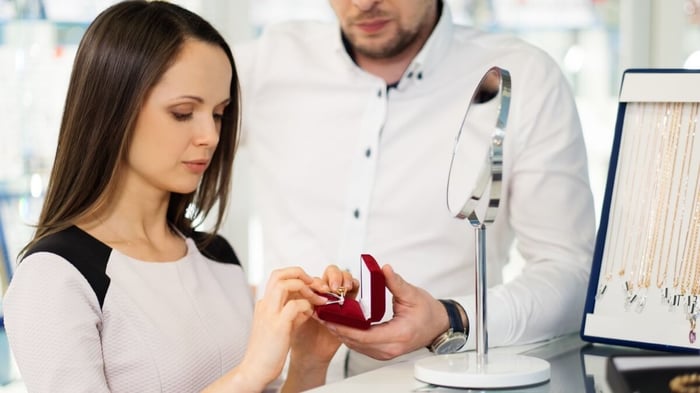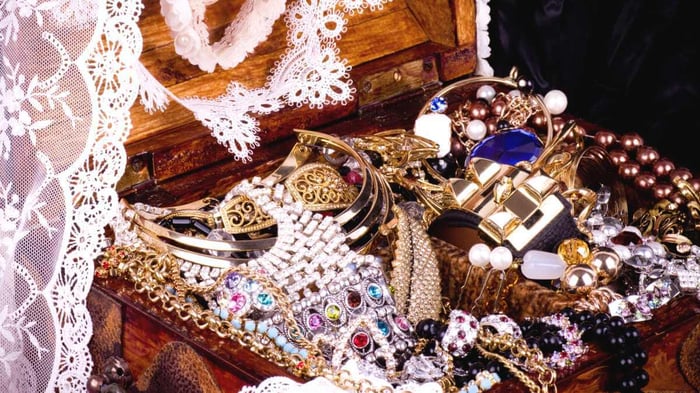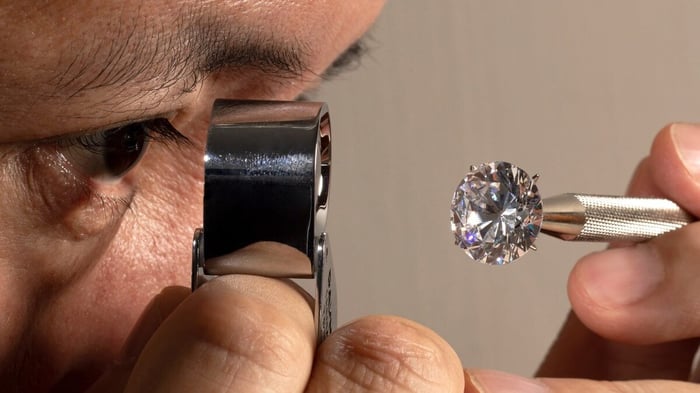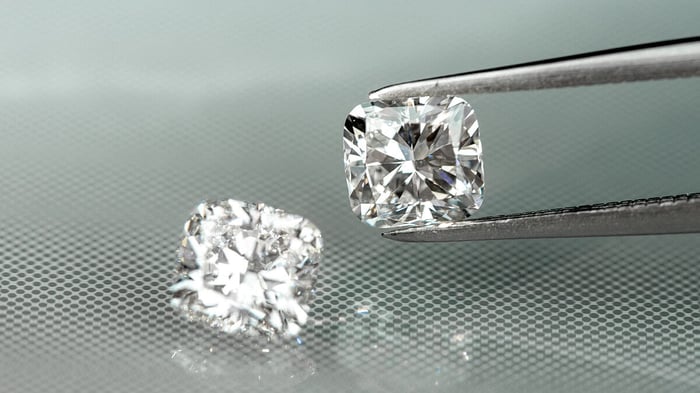Hints And Tips For Choosing Diamond Jewellery
Diamonds are meant to be worn for a very long time, so the word "forever" is often used to describe diamond jewellery. Unless it is damaged beyond repair, stolen, or misplaced, diamond jewellery is likely to be handed down through the family, becoming an heirloom.
Diamond jewellery is a favourite not just among those couples who are making plans to start a married life together. People who are interested in purchasing expensive products as an investment. While we might discuss the truth of that, it is certainly true that diamonds have often been used as a store of relatively easily portable value during hard times. But most of us buy diamonds and diamond jewellery for the beauty and pleasure they add to our lives.
Finding The Best Diamond Jewellery For A Lifetime Of Pleasure
The following should be the primary thoughts that run through your head if you are one of those people who are thinking about purchasing diamond jewellery for yourself or for someone you care about:
Diamond Clarity
When shopping for diamond jewellery, clarity is the first item that you should look for. This can be determined by the presence or absence of naturally occurring blemishes or imperfections known as inclusions. These are things that can't usually be seen with the human eye, yet nonetheless have an impact on the diamond in some way. (A helpful hint: The price will usually be greater if there are fewer and smaller inclusions.)
When examining diamond jewellery, if there are no inclusions visible under 10X magnification and with good lighting, the diamond is considered to have perfect clarity. Understanding something about diamond clarity is a big advantage when you are buying diamond jewellery.
Because internal flaws and inclusions affect the passage of light through the gemstone, a diamond with poor clarity may have less brilliance and sparkle than a diamond with fewer inclusions. The vast majority of inclusions found in diamonds of jewellery quality do not impact the diamond's performance or structural integrity, and they are not apparent to the naked eye. However, substantial clouds can potentially disrupt a diamond's capacity to transmit and disperse light. The resistance of a diamond to fracture can be lowered if it has large cracks that are either near the surface or break through it.

Diamond Colour
Diamonds can be found in various colours, but almost all of them have a hint of yellow. Despite the common perception that diamonds are colourless and transparent, diamonds actually come in a wide range of hues. The slight yellow colouration is not detectable in the vast majority of white diamonds. The difference in colour grade is so slight that it is almost undetectable to the naked eye, but it plays a significant role in determining the value of the diamond. Compared to off-white diamonds, jewellery made with colourless diamonds is considered the most valuable. "Fancy" diamonds, which can come in a variety of colours, including pink, blue, red, green, and yellow, are the only exception to the general rule. These are extremely uncommon and hold a high value to collectors. At All Diamond, most of our jewellery is made with near-colourless diamonds with a grade of G. This colour grade is a sweet spot between colour and price. Only an expert working under lab conditions would be likely to detect any hint of discolouration. However, the price is significantly lower than the colourless grades making G-grade diamonds a good buy for almost all types of diamond jewellery.
If you need to buy a diamond of a lower colour grade, possibly for budget reasons or to be able to buy a larger gemstone, then you can use yellow or rose gold in the setting to disguise any hint of yellow in the diamond. White metals may show any hint of yellow compared to the metal’s own colour.
Certified Diamond Solitaire Engagement Ring 0.40ct E/VS Quality 18k Yellow Gold

£1,126.00
£1,797.00
The natural beauty of diamonds is showcased to dazzling effect in this elegant yellow gold engagement ring. The ring features a 0.40CT and E/VS quality diamond which glistens and sparkles against the 18K yellow gold band. This ring will be… read more
Cut Quality
Cut quality is the single most important variable associated with diamond quality. It is the only aspect of a diamond under the control of the craftspeople who add facets and polish the rough diamond into the beauty we see in the jewellers and wear in our lives. The cut quality significantly impacts the brilliance, fire and sparkle of diamonds in the finished jewellery.
The skill of the craftspeople working on a diamond is their ability to create the highly polished facets in the diamond at precisely the right angles to reflect and disperse light, creating the brilliance and sparkle we demand. A poorly cut and polished diamond will have a less brilliant visual appearance and can look dull and lifeless.
The unfortunate fact that many jewellers still refer to the cut of the diamond as being the shape of the diamond leads to confusion among customers who purchase jewellery.
They use the word "cut" to refer to the natural shape of the stone, such as round (which can include modern brilliant cut, eight cuts, old cut, Swiss cut or rose cut), marquise, oval, pear, heart, and emerald or octagon. Other possible shapes include old cut, Swiss cut and rose cut. There are also individuals who prefer other shapes, such as square, oblong, triangle, princess, or radiant cuts, for their diamonds.
Cut quality is graded in diamond grading reports; most grading labs use the following terms to summarise all aspects of the cut quality: Excellent, Very Good, Good, Fair and Poor. Some labs substitute Ideal or similar terms for Excellent. Most of our diamonds are of Very Good cut quality. As with colour, this grade is a sweet spot in terms of value and quality. Most diamond buyers will not notice the difference between an Excellent and Very Good diamond, but the price difference is very significant.
Diamond Cross Necklace with 0.11ct G/SI Diamonds in 9K White Gold
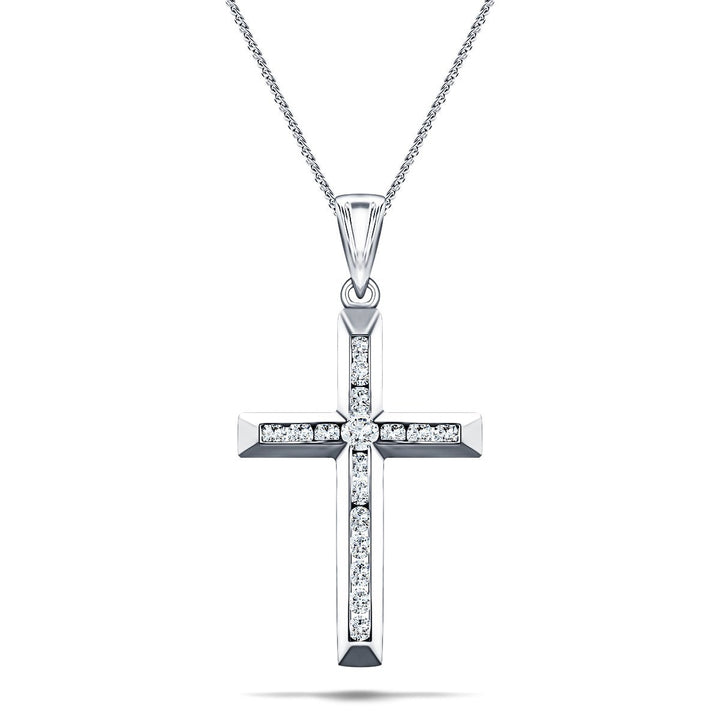
£324.00
£467.00
For a touch of elegance, look no further than this stunning diamond cross necklace. Crafted with a 9K white gold and a 0.11ct G/SI diamond, this diamond cross necklace has an elegant and delicate look that is perfect for any… read more
Carat Weight.
Despite the fact that a carat is a unit of weight and not size, the carat weight of diamond jewellery is usually used to describe the size of diamonds. Diamonds of the same weight and shape should be approximately the same size if they have been cut properly. It's not always true that bigger is better, despite the fact that many people who buy diamond jewellery might be inclined to disagree.
Even though large diamond jewellery pieces are the best way to display the stone's colour and cut, a diamond with a smaller size but the same clarity and colour, or even a more precise cut, can have the same value. It is essential not to confound size and weight in one's thinking. Always keep in mind that no two diamonds will ever be exactly the same size because the cutting and faceting of each diamond will be unique to that diamond alone. This is true regardless of how precisely the diamonds were cut.
Related to carat weight is the visual appearance of size. Some diamond shapes will look larger than others due to their proportions. For example, an emerald cut diamond has straight sides and corners with a more shallow profile as compared to a round diamond. Suppose one looks at an emerald cut and a round diamond of the same weight. In that case, the emerald will look larger when set into jewellery because more of the weight of the diamond is found toward the edges and the emerald shape has corners that extend past the circumference of the round diamond.
These attributes, Cut, Colour, Clarity and Carat weight, are referred to as the 4Cs of diamond quality. The 4Cs are used universally to describe the quality of a diamond and, with small variations in consistency and terminology, are used by all competent diamond grading organisations. Taken together, these attributes enable you as a consumer to make better choices about the diamonds or diamond jewellery that you buy and to make some kind of comparison between the jewellery sold by different retailers.
If you want to learn more about diamond quality and grading, please check out our articles on the subject elsewhere on our website.
Now, You Are A Better Informed Diamond Jewellery Buyer!
Armed with a little knowledge about diamond quality and what to look out for, choosing diamond jewellery will become easier and more fun. You are better positioned to make a good choice for your next diamond jewellery purchase. We aim to offer great value, service and quality in all the diamond jewellery that we sell.
All of our jewellery is designed and handcrafted in the UK and is sold with a lifetime workmanship guarantee and a 30-day return and exchange policy.
Please take a few minutes to browse our collections of diamond jewellery made with ethically sourced diamonds and other precious stones set into UK-hallmarked gold and platinum.
